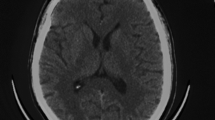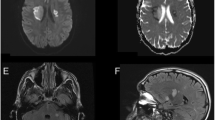Abstract
Objective.
To describe the clinical course and imaging findings in a young man who developed a spongiform leucoencephalopathy from heroin-vapour inhalation, and to discuss the treatments which may have contributed to the unexpected favourable outcome in this case.
Design.
Case report.
Setting.
Intensive care unit of a university teaching hospital.
Patient.
A patient who developed a near fatal toxic leucoencephalopathy with impressive clinical recovery and reversible white matter changes on imaging.
Measurements and results.
Successive computed tomography scans and magnetic resonance imaging over 7 months showed evolution from bilateral extensive involvement of the cerebral white matter to almost complete resolution accompanied by the development of periventricular lesions suggestive of necrosis. Despite the fact that the patient had stretching spasms for several days, the outcome was favourable with prolonged supportive care and antioxidant therapy by ubiquinone (coenzyme Q).
Conclusion.
This case demonstrates that prolonged intensive care is of paramount importance in patients with spongiform leucoencephalopathy after inhalation of heated heroin, that abnormalities of cerebral white matter may be slowly regressive, and supports the use of coenzyme Q in severe forms of the disease.

Similar content being viewed by others
References
Wolters EC, van Wijngaarden GK, Stam FC, Rengelink H, Lousberg RJ, Schipper MEI, Verbeeten B (1982) Leukoencephalopathy after inhaling "heroin" pyrolysate. Lancet 2:1233–1237
Kriegstein AR, Shungu DC, Millar WS, Armitage BA, Brust JC, Chillrud S, Goldman J, Lynch T (1999) Leukoencephalopathy and raised brain lactate from heroin vapor inhalation ("chasing the dragon"). Neurology 53:1765–1773
Sempere AP, Posada I, Ramo C, Cabello A (1991) Spongiform leukoencephalopathy after inhaling heroin. Lancet 338:320
Kriegstein AR, Armitage BA, Kim PY (1997) Spongiform leukoencephalopathy after inhaling heroin. N Engl J Med 336:589–590
Chen CY, Lee KW, Lee CC, Chin SC, Chung HW, Zimmerman RA (2000) Heroin-induced spongiform leucoencephalopathy: value of diffusion MR imaging. J Comput Assist Tomogr 24:735–737
Tan TP, Algra PR, Valk J, Wolters EC (1994) Toxic leukoencephalopathie after inhalation of poisoned heroin: MR findings. Am J Neuroradiol 15:175–178
Filley CM, Kleinschmidt-DeMaster (2001) Toxic leukoencephalopathy. N Engl J Med 425–432
Author information
Authors and Affiliations
Corresponding author
Rights and permissions
About this article
Cite this article
Gacouin, A., Lavoue, S., Signouret, T. et al. Reversible spongiform leucoencephalopathy after inhalation of heated heroin. Intensive Care Med 29, 1012–1015 (2003). https://doi.org/10.1007/s00134-003-1691-5
Received:
Accepted:
Published:
Issue Date:
DOI: https://doi.org/10.1007/s00134-003-1691-5




